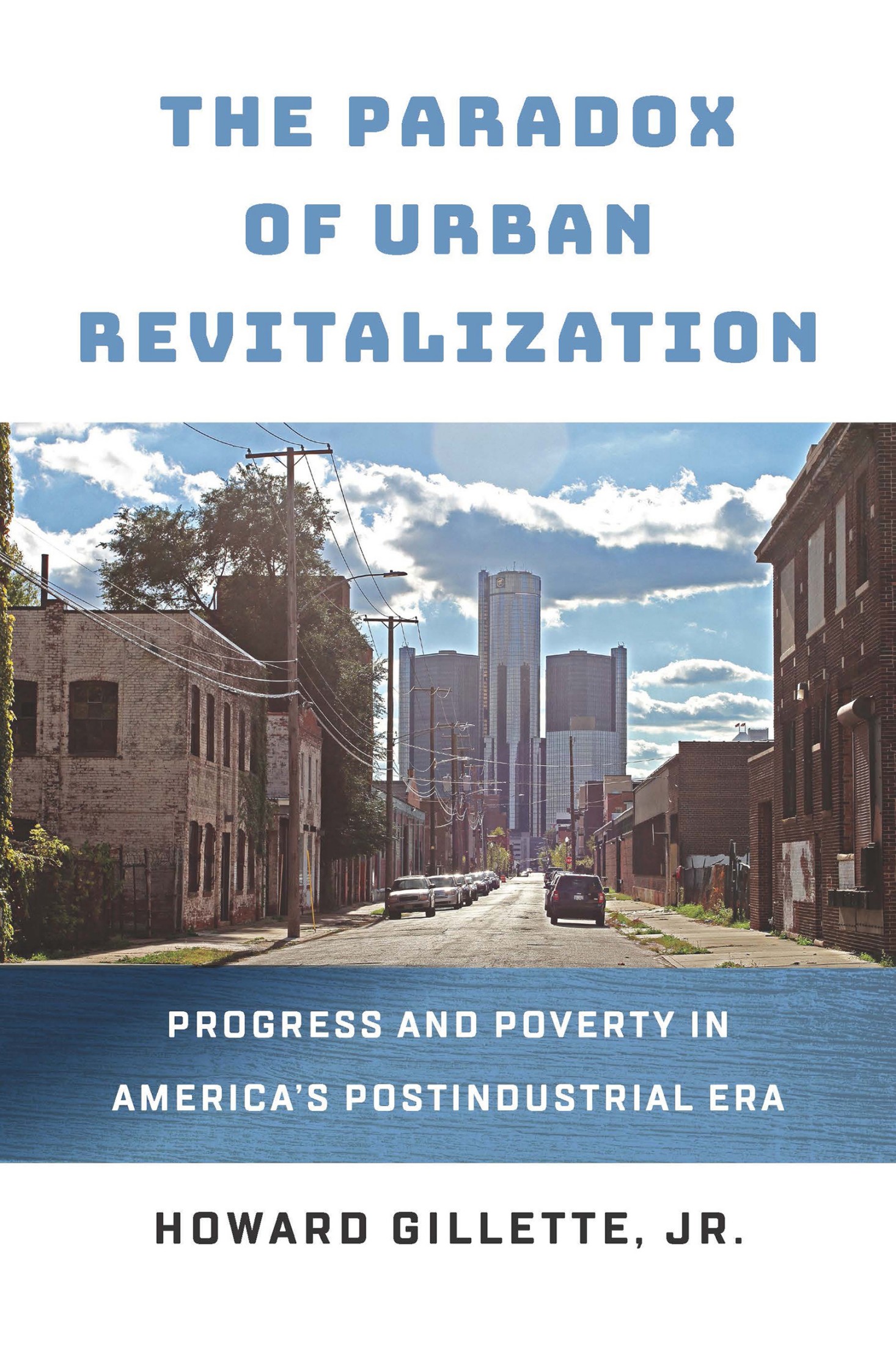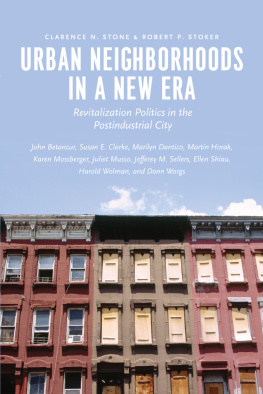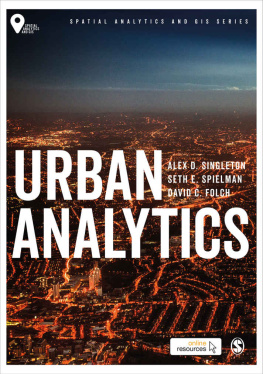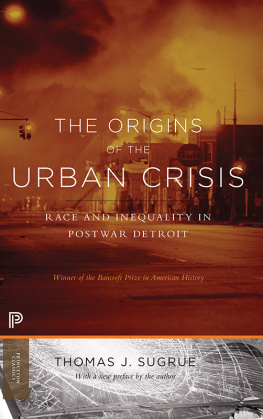Howard Gillette - The Paradox of Urban Revitalization: Progress and Poverty in Americas Postindustrial Era
Here you can read online Howard Gillette - The Paradox of Urban Revitalization: Progress and Poverty in Americas Postindustrial Era full text of the book (entire story) in english for free. Download pdf and epub, get meaning, cover and reviews about this ebook. year: 2022, publisher: University of Pennsylvania Press, genre: Politics. Description of the work, (preface) as well as reviews are available. Best literature library LitArk.com created for fans of good reading and offers a wide selection of genres:
Romance novel
Science fiction
Adventure
Detective
Science
History
Home and family
Prose
Art
Politics
Computer
Non-fiction
Religion
Business
Children
Humor
Choose a favorite category and find really read worthwhile books. Enjoy immersion in the world of imagination, feel the emotions of the characters or learn something new for yourself, make an fascinating discovery.

- Book:The Paradox of Urban Revitalization: Progress and Poverty in Americas Postindustrial Era
- Author:
- Publisher:University of Pennsylvania Press
- Genre:
- Year:2022
- Rating:4 / 5
- Favourites:Add to favourites
- Your mark:
- 80
- 1
- 2
- 3
- 4
- 5
The Paradox of Urban Revitalization: Progress and Poverty in Americas Postindustrial Era: summary, description and annotation
We offer to read an annotation, description, summary or preface (depends on what the author of the book "The Paradox of Urban Revitalization: Progress and Poverty in Americas Postindustrial Era" wrote himself). If you haven't found the necessary information about the book — write in the comments, we will try to find it.
Howard Gillette: author's other books
Who wrote The Paradox of Urban Revitalization: Progress and Poverty in Americas Postindustrial Era? Find out the surname, the name of the author of the book and a list of all author's works by series.
The Paradox of Urban Revitalization: Progress and Poverty in Americas Postindustrial Era — read online for free the complete book (whole text) full work
Below is the text of the book, divided by pages. System saving the place of the last page read, allows you to conveniently read the book "The Paradox of Urban Revitalization: Progress and Poverty in Americas Postindustrial Era" online for free, without having to search again every time where you left off. Put a bookmark, and you can go to the page where you finished reading at any time.
Font size:
Interval:
Bookmark:

THE CITY IN THE TWENTY-FIRST CENTURY
Series Editors
Eugenie L. Birch and Susan M. Wachter,
A complete list of books in the series is available from the publisher.
THE PARADOX OF URBAN REVITALIZATION
Progress and Poverty in Americas
Postindustrial Era
Howard Gillette, Jr.
PENN
UNIVERSITY OF PENNSYLVANIA PRESS
PHILADELPHIA
Copyright 2022 University of Pennsylvania Press
All rights reserved. Except for brief quotations used for purposes of review or scholarly citation, none of this book may be reproduced in any form by any means without written permission from the publisher.
Published by
University of Pennsylvania Press
Philadelphia, Pennsylvania 19104-4112
www.upenn.edu/pennpress
Printed in the United States of America on acid-free paper
10987654321
Library of Congress Cataloging-in-Publication Data
Names: Gillette, Howard, Jr., 1942- author.
Title: The paradox of urban revitalization : progress and poverty in Americas postindustrial era / Howard Gillette, Jr.
Other titles: City in the twenty-first century book series.
Description: 1st edition. | Philadelphia : University of Pennsylvania Press, [2022] | Series: The city in the twenty-first century | Includes bibliographical references and index.
Identifiers: LCCN 2021039346 | ISBN 9780812253719 (hardcover), ISBN 9780812298338 (eBook)
Subjects: LCSH: Urban renewalUnited StatesCase studies. | Urban policyUnited StatesCase studies. | Sociology, UrbanUnited States. | EqualityUnited States.
Classification: LCC HT175 .G55 2022 | DDC 307.3/4160973dc23
LC record available at https://lccn.loc.gov/2021039346
For Margaret
Everywhere is it evident that the tendency to inequality cannot go much further without carrying our civilization into that downward path which is so easy to enter and so hard to abandon. Though knowledge yet increases and invention marches on and cities still expand, civilization has begun to wane when, in proportion to population, we must build more and more prisons, more and more almshouses, more and more insane asylums.
Henry George, Progress and Poverty, 1879
For some it was Trayvon Martin; for others it was Michael Brown. For me, it was Freddie Gray: a jolt to comprehension, forged over fifty years, of cities, those who struggled most within them, and how far we had come from the urban crisis that marked the outset of my academic career. As a graduate student in 1967 I had witnessed civic uprising, or rioting as it was called at the time, in New Haven, a phenomenon that had previously been considered inconceivable in the nations model city for urban renewal. In 1971 I had discussed one-on-one with George Romney, Richard Nixons first appointment to head the Department of Housing and Urban Development, the difficulties in trying to upend the depths of urban poverty we witnessed as we drove along Detroits Woodward Avenue past a strikingly dilapidated public housing project. A few years later, I toured Columbia, Maryland, with Barry Preston, a childhood friend who worked for the new towns developer, James Rouse. Preston assured me that Rouse sought to weave into this community a pattern of integration that would serve as an antidote to the city of Baltimores long history of exclusion and segregation. Some years later, I wrote enthusiastically about the progression of Rouses career from a pioneer developer of regional malls, which did so much to undermine the commercial vitality of cities, to the point when he shifted direction to seek urban revitalization downtown and subsequently in poor, predominantly Black neighborhoods, most notably the Sandtown-Winchester section of Baltimore where Freddie Gray grew up and died as a result of police misconduct in 2015. As news accounts accumulated, it became clear that Grays neighborhood, the object of the most sensitive, sustained, and well-funded public-private investment partnership to my knowledge, had never become a location of hope and opportunity as intended. Surely, I was not the only one to ask what could have happened over time to dash such hopes for improving the life chances of Freddie Gray and those like him, whose aspirations withered under the constraints of similar areas.
On Memorial Day 2020, shortly after I had submitted this manuscript for review for publication, another Black manGeorge Floyddied at the hands of police, this time in Minneapolis. Like so many others, I was appalled by the visual record of his death, but even before it ignited worldwide protests, I had to ask again, how could this happen in this particular place? In the early 1970s I had visited the city several times to promote a new chapter of the Ripon Society, a liberal Republican research organization. My successor as president, in 1973, lived in Minneapolis, a city where even Republicans in my experience were progressive. Years later, I returned to the area to attend a conference hosted by Myron Orfield, a former state legislator and now the director of the Institute on Metropolitan Opportunity at the University of Minnesota. Orfield subsequently came to Camden, New Jerseywhere I was teaching and where the city was under state controlto make the case for the urgency of addressing the unrelenting effects created over a generation of concentrated poverty. For Orfield, as for me, Floyds death was another shock to comprehension. As Orfield and another colleague wrote ruefully, Minneapolis has abandoned its vision of an egalitarian society, stopped enforcing civil rights rules and let inequality and division fester.
In the 1960s, the deaths of Black men like Freddie Gray and the civil disorders that followed fueled acknowledgment that the United States was experiencing an urban crisis. In response, a national commission formed to investigate the sources of urban violence, the president declared a War on Poverty, and business joined philanthropic organizations to form the first community-based development corporations. In the twenty-first century, such events spurred national efforts to effect criminal justice reform, fostered a growing awareness of the persistence of racially determined inequalities, and prompted the formation of Black Lives Matter. Despite the energy behind it, the new movement remained limited in effect. When the prominent urbanist Richard Florida, pointing to growing inequalities in Americas most successful global cities, declared a new urban crisis in 2017, his message went largely unheeded. It took the profound effects of a pandemic further deepening the racial and financial divides in American cities and exposing them to public view to amass the kindling that ignited with Floyds death.
Why didnt the larger world see the explosion coming? A central reason, I argue here, was the apparent revitalization of those places where inequities were most fraught. Such claims for recovery had been made before, of course: during the era of urban renewal in the 1950s and 1960s and in the era of comeback cities in the 1980s. But renaissance, as historian Jon Teaford recounted in his expansive review of both periods, was an uneven road that made the goal of recovery from decades of disinvestment still elusive.
Urban revitalization brought with it a central paradox, however. Success in adjusting to the demands of globalization and the economic restructuring it required, deepened existing divisions of race and class. The crystallization of diverging trajectories between those taking advantage of a knowledge-driven economy and those left behind by it suggested the title of Mallachs book and prompted Floridas declaration, Much more than a crisis of cities, the New Urban Crisis is the central crisis of our time.
Font size:
Interval:
Bookmark:
Similar books «The Paradox of Urban Revitalization: Progress and Poverty in Americas Postindustrial Era»
Look at similar books to The Paradox of Urban Revitalization: Progress and Poverty in Americas Postindustrial Era. We have selected literature similar in name and meaning in the hope of providing readers with more options to find new, interesting, not yet read works.
Discussion, reviews of the book The Paradox of Urban Revitalization: Progress and Poverty in Americas Postindustrial Era and just readers' own opinions. Leave your comments, write what you think about the work, its meaning or the main characters. Specify what exactly you liked and what you didn't like, and why you think so.






